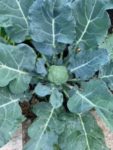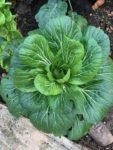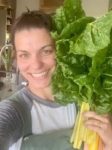January Vegetable Garden Checklist Tips from Paula Wolfel
January is surprisingly an exciting time for Austin vegetable gardeners because this is when the bulk of your spring garden planning can occur!
Continue to make preparations for the lower temperatures, and watch the rain because this time or year we can reduced our irrigations needs. Make sure you continue to protect all new transplants from freeze and their first frost. If the temperatures falls below 28 degrees then cover your plants, securing them with soil, bricks, rocks, or pins. In addition, make sure to keep an eye on temperatures near freezing and frost warnings for citrus trees: either cover them with frost cover or blankets, or if they are potted, move them inside. And finally, take advantage of the winter lull to take care of your tools. See below for tips on sharpening, cleaning, and oiling your tools.
Happy Year of the Broccoli!
 Here’s some inspiration for your January vegetable garden checklist, the National Garden Bureau has declared 2023 the Year of the Broccoli.
Here’s some inspiration for your January vegetable garden checklist, the National Garden Bureau has declared 2023 the Year of the Broccoli.
The January Vegetable Garden Checklist
Here is what you can do in the garden this month:
FERTILIZE
|
- Fertilize established plantings of asparagus late in the month to encourage healthy new shoots.
- If you planted fall garlic or have vegetables that survived the freeze, continue to feed with a liquid fertilizer every two weeks.
|
WATER
|
- Irrigate vegetable beds so that the plantings do not dry out. Irrigate only if the soil is dry a few inches below the surface, or in newly established seedbeds, or if you are not getting adequate rainfall. Dry plants are more likely to suffer freeze damage than well-watered ones, but plants use less water when temperatures are cool. Be careful not to overwater and always check soil moisture levels before watering.
|
PLANTING (with frost protection)
|
- Seeds:
- Beets (middle to late January)
- Carrots (middle to late January)
- Fava Beans (all month)
- Green, cool season (all month)
- Peas, English/now/snap (middle to late January)
- Potato, Irish (late Jauary)
- Radishes (all month)
- Turnips (middle to late January)
- Transplants:
- Artichokes (all month)
- Asparagus (all month)
- Broccoli (middle to late January)
- Cabbage (middle to late January)
- Cauliflower (middle to late January)
- Leeks (middle to late January)
- Onions, bulbing (all month)
- Seeds or Transplants:
- Asian Greens (all month)

- Collards (all month)
- Kale (all month)
- Kohlrabi (all month)
- Lettuce (middle to late January)
- Mustard greens (all month)
- Spinach (middle to all month)
- Swiss Chard (all month)
- Indoors:
- Start tomato and pepper seeds indoor. I usually start transplanting mine in mid- to- late March.
- Potatoes get planted in mid-February but they need to be cut and set out to dry beforehand.
- Start shopping seeds for the February planting season.
|
SOIL
|
- If you’ve had a vegetable garden for a few years now, have a soil test done (forms available here). It’ll help you determine which amendments to add and what to avoid. Add organic matter like compost or aged manure, fallen leaves and pine straw to your soil so there is time for it to break down before spring planting.
|
DISEASES/PESTS TO LOOK FOR
|
- Cabbage loopers, aphids, snails/slugs, and some beetles can remain active all winter (control methods can be found here in the Grow Green Guides)
- Protect plants from damage and insulate from freezing weather with a layer of row cover. This can be left on all winter. Anchor the fabric in several places with u-shaped pins, bricks, stones or sandbags. Another option is to lay 4-6 foot lengths of heavy t-posts or wooden boards along the long edge of the row. They are easy to remove if you want to lift up a section of row cover to periodically check the progress of your plants.
|
MAINTENANCE
|
- Keep up with weeds while they are young and before they have a chance to put down roots.
- Take advantage of mild winter days to tidy up your shed and greenhouse, and take care of tools.
- Keep up with the mulch (pine bark, hardwood mulch, pine straw, etc.)
- Remove annuals that were killed or burned by frost, but don’t cut back perennials yet. Wait until they start to show new growth at the base.
|
HARVEST
|
- Keep your vegetable consumption high this winter as you continue to harvest Swiss chard, kale, collards and lettuce. Use a “cut and come again” strategy. You’ll be surprised how fast everything grows.
- Cut or twist the leafy tops off of turnips, beets, radishes and carrots before storing, and don’t overlook the culinary potential of those leafy greens. They are totally edible and nutritious, especially when harvested fresh from the garden. Their flavor is transformed when chopped up and incorporated into soups, casseroles, vegetable sautés, or dips. Carrot tops make a tasty pesto for adventurous eaters.
|
Additional Resources
Watch the Vegetable Gardening in Central Texas Webinar
Recommended Vegetable Varieties for Travis County
Vegetable Seed Sources
Vegetable Gardening in Austin
Plant Rotations, Successions and Intercropping
Rootknot Nematode Management
Sustainable Food Center Farmers Markets
Texas Farmers Markets
Monthly Gardening Calendar for Austin and Central Texas
About Paula Wolfel
 Paula Wolfel is new to the Travis County Master Gardener program but has been gardening in Austin, Texas since 2017. She grew up in the suburbs of Chicago learning how to garden from both her father—a Sicilian vegetable and fruit tree gardener—and both her grandmothers, and then spent years in Virginia gardening. Paula loves gardening because she finds it to be a grounding force- it gets her out of her head and into the present. She loves the pride that comes with cooking a meal for her family with every ingredient coming from her garden… and then the humility she feels when she loses an entire crop because of Mother Nature. She finds gardening to be wisdom, lessons, best practices passed down generation to generation, season to season and hopes to share that with you.
Paula Wolfel is new to the Travis County Master Gardener program but has been gardening in Austin, Texas since 2017. She grew up in the suburbs of Chicago learning how to garden from both her father—a Sicilian vegetable and fruit tree gardener—and both her grandmothers, and then spent years in Virginia gardening. Paula loves gardening because she finds it to be a grounding force- it gets her out of her head and into the present. She loves the pride that comes with cooking a meal for her family with every ingredient coming from her garden… and then the humility she feels when she loses an entire crop because of Mother Nature. She finds gardening to be wisdom, lessons, best practices passed down generation to generation, season to season and hopes to share that with you.
 Here’s some inspiration for your January vegetable garden checklist, the National Garden Bureau has declared 2023 the Year of the Broccoli.
Here’s some inspiration for your January vegetable garden checklist, the National Garden Bureau has declared 2023 the Year of the Broccoli. Paula Wolfel is new to the Travis County Master Gardener program but has been gardening in Austin, Texas since 2017. She grew up in the suburbs of Chicago learning how to garden from both her father—a Sicilian vegetable and fruit tree gardener—and both her grandmothers, and then spent years in Virginia gardening. Paula loves gardening because she finds it to be a grounding force- it gets her out of her head and into the present. She loves the pride that comes with cooking a meal for her family with every ingredient coming from her garden… and then the humility she feels when she loses an entire crop because of Mother Nature. She finds gardening to be wisdom, lessons, best practices passed down generation to generation, season to season and hopes to share that with you.
Paula Wolfel is new to the Travis County Master Gardener program but has been gardening in Austin, Texas since 2017. She grew up in the suburbs of Chicago learning how to garden from both her father—a Sicilian vegetable and fruit tree gardener—and both her grandmothers, and then spent years in Virginia gardening. Paula loves gardening because she finds it to be a grounding force- it gets her out of her head and into the present. She loves the pride that comes with cooking a meal for her family with every ingredient coming from her garden… and then the humility she feels when she loses an entire crop because of Mother Nature. She finds gardening to be wisdom, lessons, best practices passed down generation to generation, season to season and hopes to share that with you.
